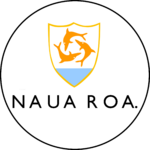Patrick Islands
Patrick Islands Naua Roa: Naua Roa | |
|---|---|
| Anthem: Kia Ma'oi | |
 The Patrick Islands in Asteria Inferior (light blue) | |
 | |
| Capital and largest city | Patrick's Town |
| Official languages | Estmerish Naua Roa |
| Ethnic groups | No data |
| Government | Unitary parliamentary elective monarchy |
| Kara Na Paoa | |
| Dara Niuꞌa | |
| Legislature | High Council of Naua Roa |
| Associated State of Sataviaa | |
| Area | |
• Total | 336 km2 (130 sq mi) |
• Water (%) | negligible |
| Population | |
• 2024 census | 28,934 |
| Currency | Satavian Guilders |
| Calling code | +51(1) |
| |
The Patrick Islands, officially and internally known as Naua Roa, are a self-governing collection of volcanic islands in free association with Satavia. The Patrick Islands, commonly called "The Patricks" or "Three Patricks" are made up of three volcanic islands - Greater Patrick, Middle Patrick and Little Patrick - with the majority of the country's population centered in Middle Patrick, in the capital of Patrick's Town.
Under the terms of the Naua Roa Free Association & Independence Act, 1989, Satavia is responsible for defence and foreign policy of the country; legally, Satavia must consult with the country's government before making any foreign policy decisions affecting the islands; however, since the Patrick Islands are not recognised as a sovereign state by the CN, foreign relations are excersised solely by Satavia and from Satavia. According to the Satavian Government, the islands are an independent state voulantarily in free association with Satavia; the Community of Nations does not recognise the current situation of the islands and maintains that they are involuntarily in association with Satavia. Consequently, the islands are not recognised as an independent country by the CN and the vast majority of member states and remain on the list of non-self-governing territories. Due to the ongoing sovereignty dispute, passports issued by the Patrick Islands are not officially accepted in the vast majority of CN member states, and as such Patrick Islands nationals have to apply for a temporary Satavian Passport to travel abroad.
With over 200,000 tourists visiting the islands in 2013, the country's largest industry is tourism, with the islands famous for their giant rock statues, Moʻai, which were designated as a CONCDCS World Heritage site in the 1996 session.
As the islands are not recognised as a sovereign state by the CN, they are not a member of any international alliance or trade bloc; but by association with Satavia are a member of ASTCOM and an associate member of the NVO.
A large military instillation on Middle Patrick, Daga Roa Naval Base is home to a large naval base and runway; which until recently also served as the island's main airport. A new international airport, Naua Roa International Airport was opened in late 2021.
History
The first settlement of the islands happened at some point between 650 and 1350 AD, although no conclusive answer has been reached. Construction of the island's famous Moai and Ahus began at some point around the 1400s until the early 1800s. Four dominant tribal kingdoms emerged on the three islands, one controlling Greater Patrick and another one controlling Little Patrick whilst Middle Patrick was split in half, one controlling the area around Daga Roa and another controlling the southern half of the island, from a small town near modern-day Rapa Ai'oa. Whilst the tribes on Greater and Little Patrick were relatively peaceful, several bloody wars raged between the two tribes on Middle Patrick. The state of perpetual warfare on Middle Patrick between the two tribes saw various examples of "stone toppling" which lead to many Moai's being destroyed. The two tribes were eventually united following the victory of Kaimama the Great. He razed the settlement, of which nothing remains to this day.
The first Euclean contact with the islands occurred on the 17th March 1699 by Estmerish captain and navigator Donald Maudley, according to his diary. Sailing on the ship HMS Longwood, he named the islands the "Patrick Islands" - after St Patrick, whose feast day occurs on the same day. The islands were claimed for Estmere, and Maudley left that day; he did not land on the islands.
The next contact would occur nearly fifty years later, in 1744, when a Gaullican navigator, Francois Jaques, landed on Middle Patrick, and found the local Naua Roa people. Jaques landing brought diseases to the islands - and the population declined by an estimated 50% in the following years. Jaques inadvertently insulted the ꞌariki of Daga Roa - and so was murdered, along with much of his crew. Some of his men escaped to their ship, from where they sailed to the Hennish colony of Satavia - but shipwrecked on the rocks off Fort Zilverzee (now Victoriaburg) - all of them except one drowned.

The next attempt at colonisation would be Estmere, in 1822. The islands had been visited multiple times since then - but no serious attempt to stay had been made. Whilst the colonisation attempt would ultimately be unsuccessful, it established the first formal relationship between the islands and a country.
The islands became a protectorate of Estmere in 1861, as the Protectorate of the Three Patricks. After prolonged negotiations, they were formally annexed by Estmere in 1892, as the Colony of Naua Roa; and they would remain as a colony administered by Estmere until 1921; when they were transferred for administration to the Dominion of Satavia.
The Patrick Islands were unaffected by the Great War, and administration carried on as usual despite the fall of Satavia. In 1936, the independence of Satavia complicated matters regarding the sovereignty of the Patrick Islands, which were annexed by Satavia in January 1937.
During the Satavian Crisis, the Patrick Islands were unaffected until the 14th March 1979; when 900 men of the far-right paramilitary De Volksmilite seized the islands. After a brief battle at Daga Roa Naval Base, which since 1975 had been inactive, had complete control of the islands; only a day later, a MANPADS shot down a Satavian Naval Service helicopter, which crashed off the coast of Middle Patrick. On 22nd March, Satavian Paratroopers landed on Little Patrick, sustaining no casualties and taking the island with no fighting. On the 23rd, paratroopers took Greater Patrick, sustaining no casualties and only encountering small resistance.
On the 26th March, Operation Thunderbolt was launched; Satavian paratroopers were assisted by a detachment of marines. After a firefight through the streets of Patrick's Town left nearly seventy De Volksmilite dead and thirteen Satavian personnel (in addition to four civilians) dead, the islands were fully retaken.
In 1989, following the 1988 Patrick Islands independence & free association referendum, in which islanders voted overwhelmingly to become an independent, associated state of Satavia, Satavia passed the Naua Roa Free Association & Independence Act, 1989, which saw the Patrick Islands officially become independent of Satavia.
The Community of Nations refused to recognise the change stating in it's 1990 Naua Roa Decolonisation Report that "Naua Roa (Patrick Islands) remain a dependent territory that has yet to be decolonised by the Federation of Satavia".
Following the rigged 2020 election which saw the PIP win with 99.7% of the votes, the Satavian Government informed the government of Naua Roa that if the election was not held again, with Satavian observers. The Naua Roan government did not reply; and so, on the 3rd January 2021, Satavian forces forced the Prime Minister to step down whilst a caretaker administration was appointed. The move was widely applauded internationally, with the Community of Nations praising the move as a step towards Democracy and Independence from Satavia.
As of 2020, only three CN member states recognise the independence of the Patrick Islands. The CN has repeatedly said that if the islands were to become a functioning, self-sufficient democracy then recognising the independence of the islands would "be the natural course".
Geography
Government
Naua Roa is a unitary parliamentary elective monarchy in free association with Satavia since independence was achieved in 1989. The head of state is the monarch, the High Chief (ꞌariki), which circulates every three years between the three native chiefs of the islands. The head of government, the Prime Minister, is elected every four years in a general election. The current High Chief is Ka'io Manakamu, and current Prime Minister is Dara Niuꞌa who has served as an interim Prime Minister since January 2021 before being elected later that year.
Regularly scheduled elections occur on the 4th April; however, the Prime Minister may call elections at any time. Ever since 1989, Naua Roa has been classified as a dominant-party guided democracy. Until the collapse of the Patrick Islands Party government following Operation Meteorite which saw Satavian troops stationed in Daga Roa Naval Base depose the government, which had won the 2020 election in a 99.7% victory, the PIP had been the only party in power since independence. The move, which was widely praised internationally, also lead to the first non-PIP government since independence, a caretaker administration. Elections occured in late 2021, which saw the election of Dara Niu'a, of the Paiga Naua Roa, who had previously served as caretaker Prime Minister since Operation Meteorite.
The legislative body of Naua Roa is the Naua Roa High Council which is the unicameral parliament of Naua Roa. It is made up of 12 elected politicians, each from a single-member constituency.
LGBT+ and women's rights are a source of much debate in the country; homosexuality is illegal on the islands, and is punishable by up to seven years imprisonment. In the Satavian 2013 Declaration on Human Rights in Naua Roa, the then-Labor government pledged to intervene in Naua Roa in the event of a conviction under LGBT+ law.
Administrative Divisions
| Map | Island | Capital | Population (2008) |
|---|---|---|---|
| Greater Patrick | Port Waga | 590 | |
| Middle Patrick | Patrick's Town | 10,242 | |
| Little Patrick | Rapa Bay | 1,769 |
Foreign Relations
Naua Roa's Foreign Relations are managed from Port Hope, in Satavia. Under normal circumstances, foreign relations would be conducted from Port Hope by Satavia but in consultation with the Patrick Islands Government. However, due to the lack of international recognition for the islands, relations are exercised solely by Satavia from Satavia. According to the Satavian government, when international recognition for the islands is achieved, relations will then be exercised in consultation with the government of Naua Roa.
Demographics
2008 Census
Following the 2008 Census, the population of Naua Roa stood at 12,601. As of 2020, no estimates or censuses have been held since 2008, although a new census is planned for 2022. At the census, no ethnic or religious data was collected.
Settlements
The vast majority of the Patrick Island's population live on the island of Middle Patrick, with the least populous island being Greater Patrick which was evacuated almost entirely after the erruption of Mount Ashford in 1983 with the exception of Port Waga, which was unaffected and remains the only inhabited settlement on the island. Over half of the population live in the capital of Patrick's Town. Rapa Bay and Karewaguna are the two largest settlements on Little Patrick, with the former being the largest tourist destination, with nearly 50,000 people arriving annually.
| Rank | District | Pop. | |||||||
|---|---|---|---|---|---|---|---|---|---|
 Patrick's Town  Daga Roa |
1 | Patrick's Town | Middle Patrick | 7,105 |  Rapa Bay  Port Kirk | ||||
| 2 | Daga Roa | Middle Patrick | 1,393 | ||||||
| 3 | Rapa Bay | Little Patrick | 1,108 | ||||||
| 4 | Port Kirk | Middle Patrick | 873 | ||||||
| 5 | Karewaguna | Little Patrick | 661 | ||||||
| 6 | Rapa Ai'oa | Middle Patrick | 599 | ||||||
| 7 | Port Waga | Greater Patrick | 590 | ||||||
| 8 | Nui Ta'onga | Middle Patrick | 117 | ||||||
| 9 | Ara'io | Middle Patrick | 112 | ||||||
| 10 | Northern Point | Middle Patrick | 43 | ||||||
Culture
Media
Two newspapers are registered with Satamedia, Satavia's national media regulator, the apolitical Patrek Haba Telegraph and the center-right Daily Standard. Only one broadcasting service exists on the island, SBC Naua Roa which is also the island's national broadcaster. It has two televesion channels, ChannelOne and SBC1 Naua Roa, in addition to one radio service, Naua Roa Radio.
Language
The most commonly spoken language on the islands is Naua Roa, with an estimated 96% proficiency rate, followed by Estmerish, which is spoken by 33% of the population. Naua Roa has been spoken by the locals since islanders arrived from Charlotte Island.
Moai
The islands are famous for it's Moai and Ahus, which since 1996 have been a World Heritage Site.
Public holidays
| Date | Name | Holiday | Notes |
|---|---|---|---|
| 1 January | New Year's Day | ||
| 2 January | Day after New Year's Day | ||
| 17 March | St Patrick's Day | Sometimes called "Discovery Day"; marks the first sighting of the islands by Eucleans | |
| 26 March | Liberation Day | Celebrates the re-capture of the Patrick Islands following the DV occupation | |
| 4 April | Independence Day | Also election day | |
| Movable in Spring | Good Friday | No longer a holiday since 2018 | |
| Movable in Spring | Easter Monday | ||
| 24 December | Christmas Eve | ||
| 25 December | Christmas Day | ||
| 26 December | St Stephen's Day | ||
| 31 December | New Year's Eve |



